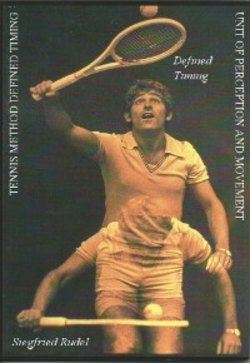Читать книгу Tennis Method - Defined Timing - Siegfried Rudel - Страница 11
1.5 Own and outside speech
ОглавлениеDefined timing offers the possibility of influencing imagination by speech/verbal accompaniment so that a controlled movement can be learned. The invariance of movement rhythms, created by the constancy of time in the vertical aspect, makes possible a simultaneous, i.e. synchronous verbal accompaniment of the movement. In doing so, the form can be made finer by the contents of the words; moreover, the connection of the words as far as time is concerned can be followed. If one counts at the moment of ball contact (series number of strokes), one becomes conscious of the ball contact. If, on top of that, one counts the hitting points of one's partner, one also becomes conscious of the time available for the backswing and the stroke. This optimal utilization of the time available for the return of the ball according to one's objective is achieved via the contact-face form movement which must be learned. The contact-face form movement conveys the movement rhythm: timing a, time experienced A loud verbal accompaniment of the movement brings about the integration of the rythm into the movement. Contrary to thinking out loud, the spokenwords have, apart from their mental contents, a time structure.
So the simultaneous verbal accompaniment makes it possible to imagine the mental contents and the grasping of a universal phenomenon, namely gravitation, which is a part of nature and which physics expresses in terms of laws. The ambiguous unit of concentration and meditative process can be found in the spoken word. Perception as a kind af fixation (cf. C.F.v.Weizsäcker 1983) is given its identity in the simultaneous grasping of the total action.
Whereas with the beginner first of all the period for hitting ('sticking-drawing') the ball is more important in order to find the hitting point, the ball control by means of 'guiding' becomes more important after one has learned the total rhythm. But only by grasping their interrelation can the backswing and the stroke be developed to increasingly dynamic and exact movements. Hitting the ball as a point of the guiding path only has the meaningless function of revealing the physical data of the ball curve by a force vector afterwards. The biological act which is responsible for the result cannot be explained by this.
While practising one speaks and hears one's movement. If one also accompanies the movements of one's partner verbally, one helps him in timing and trains oneself in watching and grasping one's partner'' movement which determine one's future (next ball to hit). If both players (figure 6) accompany their own and their partner's movements verbally, an automatic correction of timing ('mirror image'/ model) is done by means of the synchronousness of the language ('chorus').
In both cases a continuous concentration is achieved, a flowing 'thread', which cannot be disturbed by influences outside the game. This process is responsible for creating this absentmindedness which is characteristic of all playful acts.
Figure 6 : Identity of mirror movement and synchronous speech
